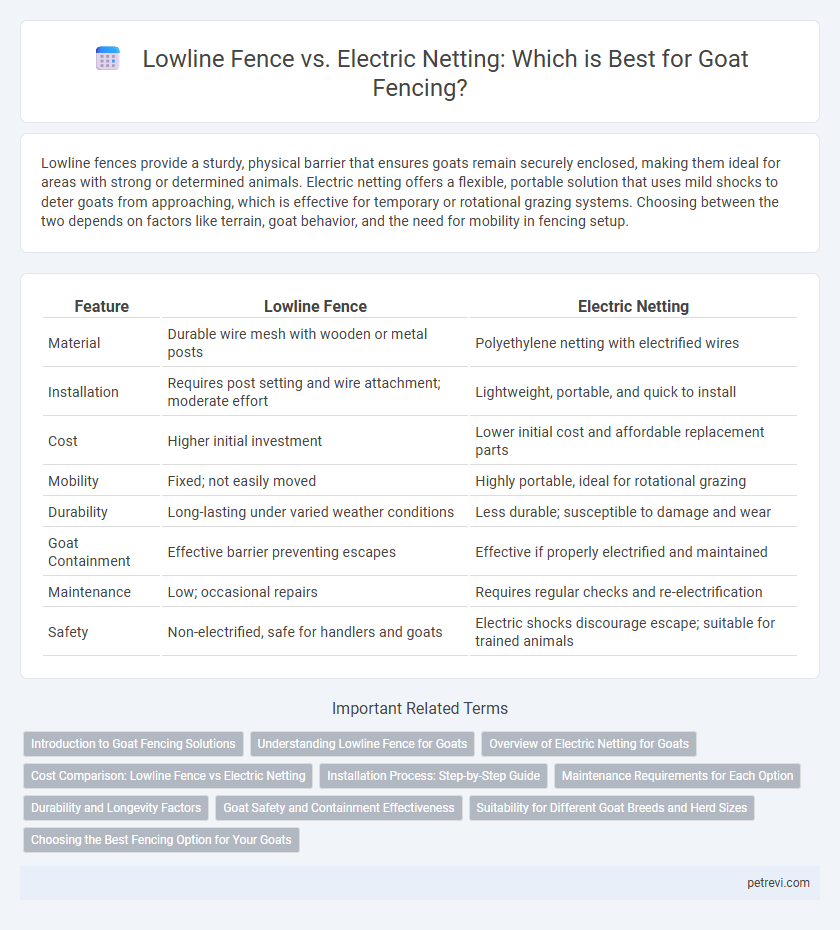Lowline fences provide a sturdy, physical barrier that ensures goats remain securely enclosed, making them ideal for areas with strong or determined animals. Electric netting offers a flexible, portable solution that uses mild shocks to deter goats from approaching, which is effective for temporary or rotational grazing systems. Choosing between the two depends on factors like terrain, goat behavior, and the need for mobility in fencing setup.
Table of Comparison
| Feature | Lowline Fence | Electric Netting |
|---|---|---|
| Material | Durable wire mesh with wooden or metal posts | Polyethylene netting with electrified wires |
| Installation | Requires post setting and wire attachment; moderate effort | Lightweight, portable, and quick to install |
| Cost | Higher initial investment | Lower initial cost and affordable replacement parts |
| Mobility | Fixed; not easily moved | Highly portable, ideal for rotational grazing |
| Durability | Long-lasting under varied weather conditions | Less durable; susceptible to damage and wear |
| Goat Containment | Effective barrier preventing escapes | Effective if properly electrified and maintained |
| Maintenance | Low; occasional repairs | Requires regular checks and re-electrification |
| Safety | Non-electrified, safe for handlers and goats | Electric shocks discourage escape; suitable for trained animals |
Introduction to Goat Fencing Solutions
Lowline fences provide a sturdy physical barrier ideal for containing goats, typically constructed from high-tensile wire and wooden posts to withstand goat pressure. Electric netting offers a flexible, portable fencing option that delivers mild electric shocks to deter goats from escaping, suitable for rotational grazing systems. Both fencing solutions optimize containment and safety, with Lowline fences excelling in durability and electric netting offering ease of installation and adaptability.
Understanding Lowline Fence for Goats
Lowline fence offers a durable and economical solution for goat containment, featuring closely spaced horizontal rails that prevent goats from escaping or injuring themselves. Its solid construction is ideal for managing goats' natural climbing and jumping behaviors, minimizing the risk of fence damage or goat entanglement often associated with electric netting. Compared to electric netting, Lowline fencing reduces maintenance needs and provides a long-term barrier suited for various goat breeds and farm environments.
Overview of Electric Netting for Goats
Electric netting for goats provides a flexible and portable fencing solution designed to contain and protect goats effectively. Constructed with durable polyethylene mesh and electrified wires spaced to prevent escapes, this system deters goats from pushing through or climbing over the fence. Its lightweight structure allows for easy installation and relocation, making it ideal for rotational grazing and temporary pastures.
Cost Comparison: Lowline Fence vs Electric Netting
Lowline fence costs typically range from $3 to $5 per foot, offering a durable and long-lasting solution for goat containment, while electric netting generally costs between $1.50 and $3 per foot, providing a more affordable but less permanent option. Maintenance expenses for electric netting can add up due to battery replacements and repairs, whereas lowline fences require less frequent upkeep but higher initial investment. For budget-conscious farmers, electric netting presents a cost-effective choice, but those seeking a sturdy, low-maintenance barrier may prefer the upfront cost of lowline fencing.
Installation Process: Step-by-Step Guide
Lowline fence installation for goats involves setting sturdy wooden or metal posts spaced 6-8 feet apart, securing multiple horizontal rails or wires at varying heights to prevent escapes. Electric netting requires unrolling the lightweight mesh around the perimeter, anchoring posts at regular intervals, and connecting the energizer to deliver a consistent, low-voltage shock to deter goats. Both methods need tension adjustments after initial setup to maintain effective containment and goat safety.
Maintenance Requirements for Each Option
Lowline fences require routine inspection to tighten wires and repair any bent or broken posts, with maintenance focused on ensuring physical barriers remain intact against goat pressure. Electric netting demands regular battery or power source checks, along with vegetation control to prevent shorts and maintain optimal conductivity for effective containment. Both systems need seasonal adjustments to address environmental impacts, but electric netting generally requires more frequent electrical component upkeep.
Durability and Longevity Factors
Lowline fences made from high-tensile wire and sturdy wooden posts offer exceptional durability and a longer lifespan, typically lasting over 10 years with minimal maintenance. In contrast, electric netting provides flexibility and ease of installation but generally has a shorter lifespan, often requiring replacement every 3 to 5 years due to UV damage and wear. The choice between the two depends on the specific environmental conditions and long-term investment priorities for goat containment.
Goat Safety and Containment Effectiveness
Lowline fence provides a sturdy physical barrier that ensures goat safety by preventing escape and minimizing injury risk through durable materials and secure construction. Electric netting offers effective containment by delivering a mild deterrent shock, discouraging goats from pushing or leaning on the fence while remaining safe when properly installed and maintained. Both fencing types require regular inspection to maintain integrity and effectiveness in protecting goats from predators and accidental escapes.
Suitability for Different Goat Breeds and Herd Sizes
Lowline fences provide a sturdy and durable barrier ideal for larger goat breeds that require strong containment, making them suitable for sizable herds requiring secure boundaries. Electric netting offers flexible, portable fencing that adapts well to smaller breeds and rotational grazing systems, accommodating herds of varying sizes with ease. Selecting the right fence depends on breed-specific behavior and herd size, balancing containment strength with ease of installation and mobility.
Choosing the Best Fencing Option for Your Goats
Lowline fences provide sturdy, durable barriers ideal for containing goats while minimizing injury risks due to their rigid posts and heavy-duty wire mesh. Electric netting offers flexibility and easy installation, creating an effective deterrent by delivering mild shocks to prevent goats from testing boundaries. Choosing between these options depends on your terrain, budget, and the intensity of containment needed to ensure both goat safety and pasture protection.
Lowline fence vs Electric netting for Goat fencing Infographic

 petrevi.com
petrevi.com